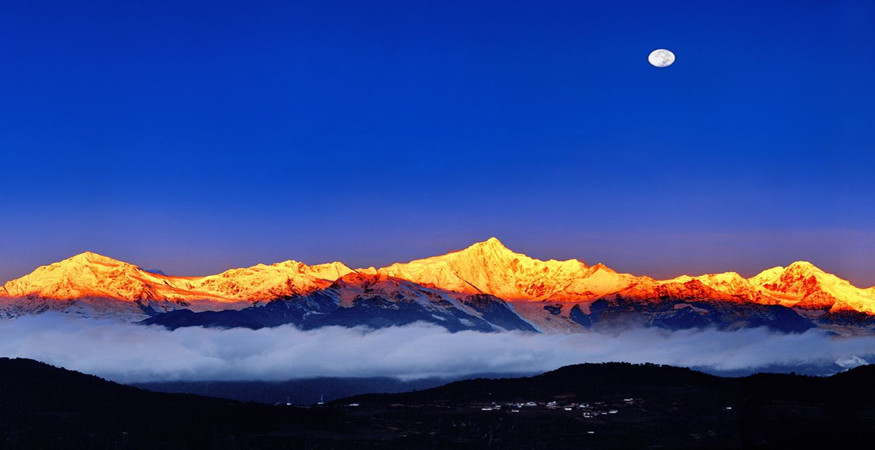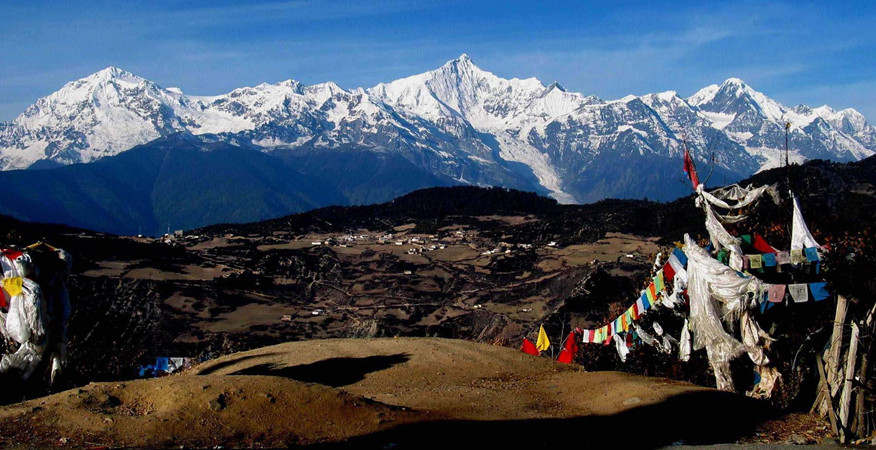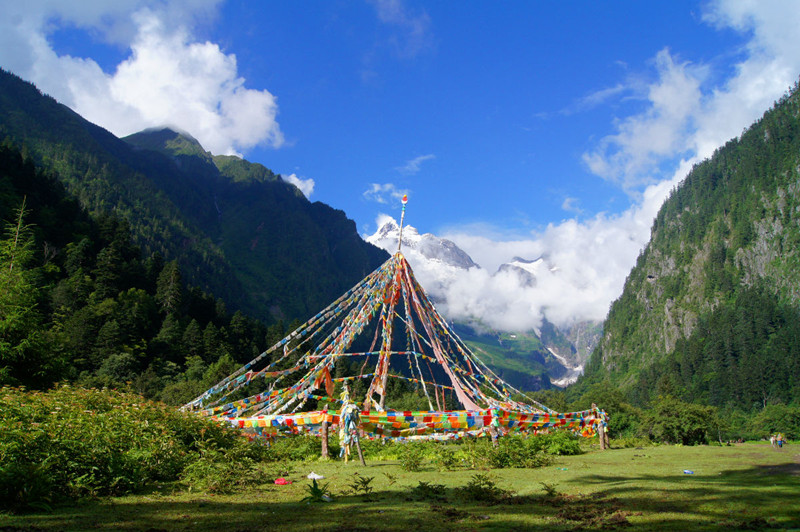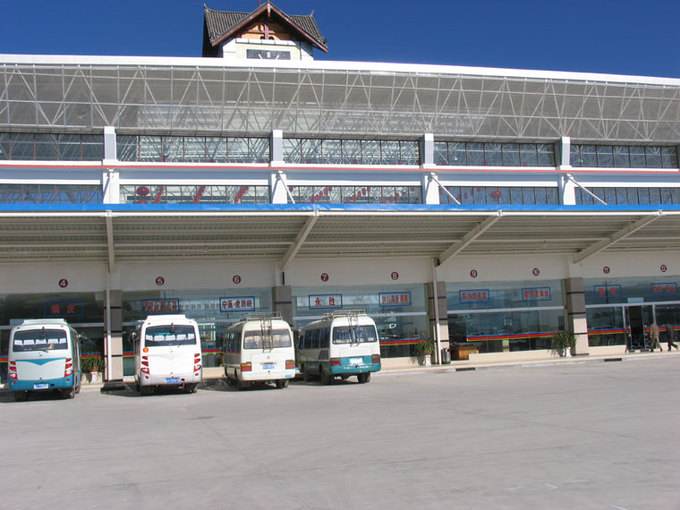
Meili Snow Mountain in Diqing

Attractions Overview
There are 13 peaks with an average altitude of over 6,000 meters on Meili Snow Mountain, referred to as the 13 prince peaks.
Chinese name: 梅里雪山
English Name: Meili Snow Mountain
Type: Mount Benri, Moerduo Mountain, Kawagebo Peak of Meili Snow Mountain, the Aemye Ma-chhen Range, Mount Kailash, Gaduojuewo, Yalxiangbo and the Himalayas
Seasons: between October and March
Recommended Visiting Time: 2~4 hours
Opening Hours: Open all day
Tickets: ¥0
Address:Meili Snow Mountain is located about 10 kilometers north-east of Deqin County, Diqing Tibetan Autonomous Prefecture of Yunnan Province.
Meili Snow Mountain is located about 10 kilometers north-east of Deqin County, Diqing Tibetan Autonomous Prefecture of Yunnan Province. It is 849 kilometers away from Kunming.It is a holy land of pilgrimage for Tibetan Buddhists, and ranks the first among the eight sacred mountains in Tibet (the eight sacred mountains: Mount Benri, Moerduo Mountain, Kawagebo Peak of Meili Snow Mountain, the Aemye Ma-chhen Range, Mount Kailash, Gaduojuewo, Yalxiangbo and the Himalayas).
There are 13 peaks with an average altitude of over 6,000 meters on Meili Snow Mountain, referred to as the 13 prince peaks. The main peak, Kawagebo, is a snow mount in a pyramid shape, commonly known as the Goddess of Meili Snow Mountain.So far, no one has ever climbed up to the summit of Kawagebo, which is 6,740 meters above sea level and the highest peak in Yunnan. The famous superb scenery of the sun shining over the snow mountain attracts a great number of backpackers.
 Meili Snow Mountain
Meili Snow MountainMeili Snow Mountain, also named as Prince Snow Mountain, is located 10 kilometers (6.2 miles) northeast of Deqin County of Yunnan Province. It sits on the border of Yunnan Province and Tibet. The three famous rivers Jinsha River, Mekong River (Nu River) and Salwen River(Lancang River) flow through the area.
It’s known for the grandest view in Yunnan Province, Meili Snow Mountain boasts a number of snow-clad ridges and peaks, thirteen of which exceed 6,000 meters (19.685 feet) above the sea level. The most splendid view is the Kawagebo Peak, the highest in Yunnan Province rising about 6,740 meters (22,112.86 feet). It is still a ‘virgin peak’ for no one has ever reached the top. Thus, Meili Snow Mountain is a challenge for all mountain explorers from home and abroad.
 Meili Snow Mountain
Meili Snow MountainThe continuous mountain ridges feature snowy peaks and the sun throws golden lights on the low-floating clouds and the top of the snow peak which form various extraordinary scene. But mostly, the mountain presents itself as mystery when dense fog and clouds made it a gleaming sight to see and you could hardly resist the temptation to unveil it. You can have a panoramical view of the thirteen towering peaks from the Feilai Temple viewing platform which is facing Meili Snow Mountain. it stretches for several hundred kilometers and accounts for 34.5% of the total area of Deqin County.
From the foot of the Kang Karpo Peak, you see the unique low-altitude glaciers formed in modern times. Strong updrafts collide with cloud airflow from the inner continents in this area producing frequent dense fog and heavy snow. The topographic extremes result in the hanging glaciers, icefalls and snow slides. The Mingyong Glaciers, in particular, rushes from an elevation of 5,500 meters (18.045 feet) down to the forest zone 2,700 meters (8,858 feet) above the sea level in rainy seasons. It looks like a huge white snake wriggling its way among the verdant mountains from afar. On the south side of the peak, a waterfall named ‘holy collapsing rain’ falls from thousands of meters high. Pure water splashed from snow cracks with the help of the sunlight, rainbows are often catched above the fall.

Owing to its high altitude, the mountain owns several climatic zones with a diversity of plants, vast expanse of grassland and rich fungi species that are vertically distributed. The types of vegetation here range from the Torrid Zone to Frigid Zone vertically. From the altitude of 2,000 meters (6562 feet) to 4,000 (13123 feet) meters, forests flourish with varieties of spruce. The depth of the forest is an exotic world of rare birds and animals. The meadows surrounding the forests are embellished by endless flowers which add more vitality and charm.
Meili Snow Mountain is one of the most sacred mountains of Tibetan Buddhism. ‘Kang Karpo Peak’ means the God of Snow Mountain in Tibetan, and is a holy land for worshiping. Pilgrims from Tibet, Qinghai Province, Sichuan Province,and Gansu Province come here at the beginning of each winter to worship. Thousands of devout pilgrims worship together and encircle the holy mountain, adding even more mystery and loftiness to it.
Climate & When to Go
 Yubeng Village in Deqin County Diqing
Yubeng Village in Deqin County DiqingDue to the topography from north to south, the river valley opens toward the south, which enables the airflow to rise upwards in the valley. With strong influences by monsoon, distinct wet and dry seasons, and high and steep mountains, it presents a highland cold temperate climate. In summer, the temperature is 11-29℃. Compared to the valley area, the temperature is 10-20℃ in the mountainous area the coldest month is from December to February. In January, the temperature is 7-12 degrees during the day and 2-5 degrees at night. During the period between November and March, the weather is very nice. In winter, there are a few days of snow, which may stop visitors passing with their vehicles.
Besides the complex topography, Meili Snow Mountain is much more complex in its weather changes. It may snow, rain or turn cloudy or sunny within a few seconds. The average annual rainfall is 600 millimeters, and the rainy season is generally between July and August.
The ideal seasons to visit Meili Snow Mountain are from October to May. The best season is after the end of October, when you can view the main peak because of the nice weather, clean air and the high transparency there. However, in other seasons, to see the main peak you have to depend on your luck. You are more likely to have a chance to see the snow-covered mountain in the early morning when the sun has just come out.
Transportation
Meili Snow Mountain, also known as Prince Snow Mountain, is located 10 kilometers northeast of Deqin County of Yunnan Province. It sits on the border of Yunnan Province and Tibet. It is mostly accessible from Deqin County by road. But the condition of the road between Meili Snow Mountain and Shangri-la is quite steep. One should make preparation for the jolt and bump.
How to Get to Meili Snow Mountain from Shangri-la
 Shangri-la Bus Station
Shangri-la Bus Station- By coach/bus
There is only one road from Shangri-la to Meili Snow Mountain and no direct bus heading to Meili Snow Mountain. Visitors should take the bus departing from Shangrila County to Deqin County first. There are only 4 buses every day and they depart at 7:20, 8:20, 9:20 and 12:00. It takes about 7 to 9 hours. The ticket is 100 yuan. Then you can change to a taxi or minibus to reach Feilai Temple, which is the Viewing Platform of Meili Snow Mountain, which takes 20 minute. - Car Rental
Renting a car is suitable for a flexible and comfortable way. If there are enough people in your group to share the expense, it is better for you to rent a car with an experience drive and a tour guide if you are foreign travelers. If you want to have more fun on the way, renting a car is highly recommended way. On the way, there are famous attractions like Nixi Village, Benzilan, Great Bend of Jinsha River, Baima Snow Mountain, Dongzhulai Monastery, Feilai Temple, etc. the driver of chartering car can stop for you to enjoy the scenery and take photos. But a tourist bus will not stop on the way.
Festivals and Activities
The area around Meili Snow Mountain is a sparsely populated region. Most of the inhabitants are Tibetans. The biggest event should be the Inner Pilgrimage and the Outer Circumambulating Pilgrimage. Pilgrimage is the custom of Tibetan people, it’s an act of religious observance and respect for nature, undertake a pilgrimage on foot around some sacred places like a mountain, a lake or a temple. Each year multitudes of pilgrims spare no efforts and travel long to conduct their Buddhist circumambulations to Holy Mountains and Lakes for good luck and ascending to the paradise after death.
There are two trekking route, one is outer circumambulation,another one is inner circumambulation. The Inner Circumambulation is easier hiking route which will cost about 6 days, And the Outer Circumambulation would take 7-15 days.
The Route of Inner Pilgrimage
- Xidang Village- Ninong Village- Lower Yubeng(Sacred Waterfall and Sacred Lake)-Upper Yubeng- Xidang Spring
- Xidang Village- Upper Yubeng(Ice Lake)- Lower Yubeng(Sacred Waterfall and Sacred Lake)- Ninong Village- Xidang Spring
The Route of Outer Pilgrimage
Deqin County Center- Yunling Town- Yangla Village(1950)- Yangza Suspension Bridge- Yongjiu Village(northwards) or Yongzhi Village(southwards) – Yongshitong- Dekangyading- Duokeyaka- Shusutong- Qienatong- Abing- Lakangya(near Nu River, at an altitude of 1700m)- Zhana- Longbu- Damuyaka- Gebu- Daguya(4100m)- Gezaya(4300m)- Meijiubugong- Shuoya(4828m)- Dulongyong- Meilishui(near Lancang River)- Adong River- Deqin











